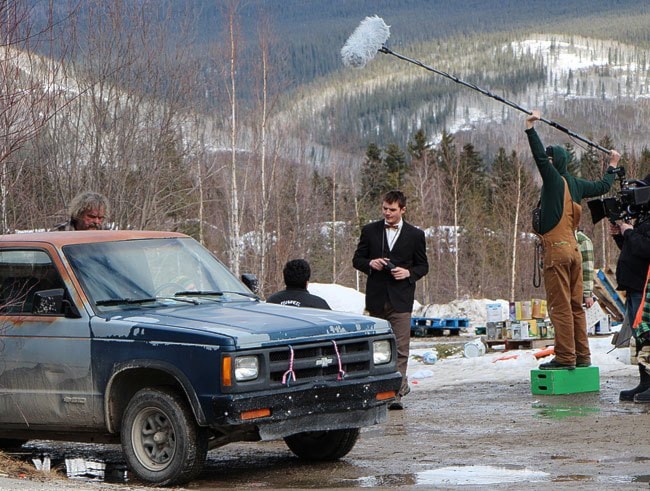Two summers ago Dawson City writer and director Lulu Keating looked around and realized there were five reality TV shows being filmed in town.
In recent years reality shows have become rife in the Klondike, portraying the region’s gold rush history and its mining and hunting industries.
That summer, four of the shows filming were being run by companies based Outside.
Keating, along with Yukon producer Max Fraser, has taken a different approach for the latest TV miniseries to air on Northwestel’s Community Television channel.
Broke Down Dawson Town is a fictional take on life in modern Dawson. The cast of the comedy-drama is made up entirely of Dawsonites, and the crew that brought it to life were all Yukoners.
“I’ve been attracted to places where I can be true to myself without feeling railroaded into somebody else’s image and I think that’s true for a lot of people who have chosen to live here, who are newer migrants,” said Keating, who moved to Dawson from Antigonish in 2004.
“The series is definitely a celebration of strong, unique, local characters and colourful characters.”
Broke Down Dawson Town stars Stephanie Davidson, who also co-wrote the episodes, and Brian Willdey, as Tom and Harry (short for Harriet).
The Nova Scotia couple arrive in Dawson penniless and move into the Westminster Hotel with a friend, the aptly-named Dick.
From there the newcomers do their best to try and fit in to their new community.
“The look of the town and the ambiance of the town, we wanted to portray that as much as possible,” Fraser said.
“So as far as we’re concerned Dawson is a character.”
With only two episodes, Broke Down Dawson Town is as mini as you can get while still being a series. But that doesn’t mean its creators have pint-sized aspirations.
The plan is to take the two episodes and shop them around to larger broadcasters and production companies as a quasi-pilot for a longer television series, Fraser said.
They want broadcasters to see the potential in a full series filmed in Dawson.
Fraser said the show has things in common with other successful Canadian series.
“The tone of the show is charming, like Corner Gas is charming,” he said.
“The characters are immediately warm to the audience.”
Then there’s what Fraser affectionately calls “The Pit subculture.”
Many scenes in the shows were filmed at the iconic Dawson watering hole or upstairs in the hotel.
“It’s got kind of The Pit subculture that echoes Trailer Park Boys,” he said, though the characters are less extreme than that show’s main trio.
Though Fraser admits the success of reality television is “a mystery” to him, the success of those shows is a sign there is an appetite for this kind of scripted series, he said.
“I think audiences across the country, and in other countries, would be very interested in this.”
One of the benefits of being a northern mecca for Outside reality TV shows is that in the off-season there’s lots of talent available to work.
“We have the potential, but people are just in the habit of thinking, ‘Oh, well we need a company from Outside to do that,’” he said.
“This is part of the bigger, broader agenda for the film community here. We’re having to prove ourselves to people in our own community and our own local governments as well as people Outside that we have the capacity and we have what it takes here to do a job that can compete nationally and internationally.”
Funding for film projects rarely comes from one place. That helps explain why it’s taken years for these two episodes to make their way to film.
The series’ two main characters were first created for two short films Keating, Davidson and Willdey worked on in 2010 and 2013.
A change to the Canada Media Fund in 2014 was critical to the characters making their way to TV.
The national organization, which promotes the production of Canadian content, offers an incentive to northern companies looking to film. But until that year creators usually had to have a deal with the country’s larger broadcasters to qualify for the funding.
The change meant projects licensed by community cable stations, like Northwestel’s, could trigger cash, Fraser explained.
“When the Canada Media Fund made their announcement it kind of took everybody by surprise,” he said.
“It was good news but people had to adjust to the circumstances.”
That money, combined with federal and territorial grants and cash from individual sponsors, was enough to cobble together a budget of $100,000.
Nobody worked for scale. They got paid about half of what they would for a properly funded conventional shoot, Fraser said. But it was enough to get the two 25-minute episodes done.
The money was lined up by January 2015 and that’s when things “went into fast motion,” Fraser said.
Ten days of filming started that April.
The two episodes premiered on Community Television Wednesday. They’ll be re-airing back-to-back every night at 9 p.m. and 11 p.m. until April 10, with the exception of Friday night because of radio/TV bingo.
Fraser said he and Keating have already started making contact with people who might be interested in funding the development of the series into a full season.
“I think that’s its biggest strength, that it’s genuine, authentic Yukon content.”
Contact Ashley Joannou at
ashleyj@yukon-news.com
